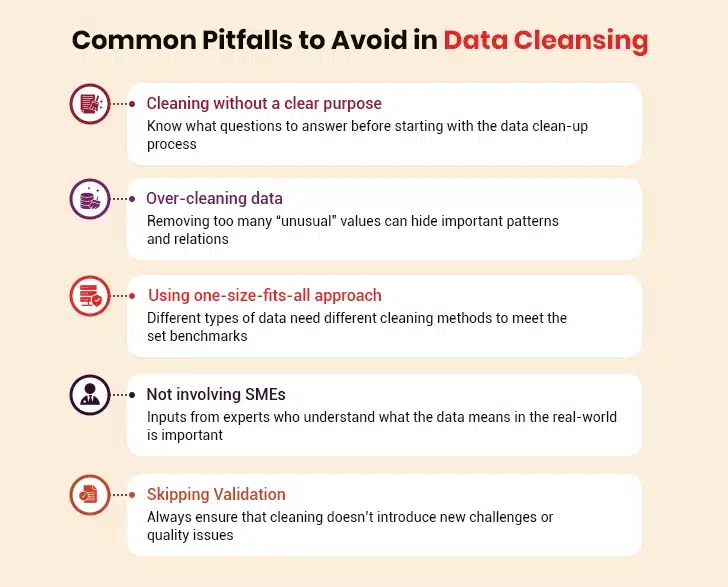The most expensive mistake in modern business isn’t failed product launches or missed market opportunities. Rather it’s the silent erosion of decision-making accuracy caused by poor-quality data. While boardrooms debate AI strategies and digital transformation budgets, the foundation supporting these initiatives often resembles quicksand more than bedrock! The uncomfortable truth? Predictive models built on flawed data don’t create competitive advantage but surely amplify disadvantage.
The statistics narrate a similar story. Data teams spend 30-40% of their time handling data quality issues instead of working on revenue-generating activities. That’s because poor-quality data leads to financial losses, missed opportunities, and compromised compliance. And basing predictive models on such subpar data directly impacts its accuracy through the “garbage in, garbage out” principle. This calls for effective data cleansing for machine learning.
Table of Contents
Enhancing Predictive Modeling with Effective Data Cleansing: Techniques and Best Practices
Link Between Data Cleansing and Predictive Accuracy
Recommended Data Cleaning Techniques
- I. Text Standardization
- II. Imputation Methods
- III. Anomaly Detection
- IV. Data Parsing
- V. Regular Expression Cleaning
- VI. Normalization
Organizations chasing the latest AI and ML innovations often overlook the fact that even the most sophisticated predictive models collapse when built on faulty data foundations. It’s like constructing a skyscraper on quicksand. That said, the competitive edge isn’t having more data, but having clean, reliable data that tells the “actual” truth.
“No data is clean, but most is useful.”– Dean Abbott, Co-Founder, SmarterHQ
Data is usually inaccurate, inconsistent, and incomplete, creating “noise.” This noise isn’t helpful for business initiatives, rather it impedes efforts, whether used for decision-making, improving operational efficiency, or developing AI and ML models. The uncomfortable reality? A significant 67% of the organizations surveyed don’t completely trust the data they’re using for decision-making. The figure is concerning as basing predictive models on poor-quality data undermines it reliability, making the endeavor loss than investment.
Thus, enters data cleansing, also called data cleaning, a crucial step in preparing data for predictive modeling. The process involves finding and removing anomalies in data, such as errors, gaps, or duplicates. Imagine data cleaning as arranging a messy room. Just as clutter makes it tough to find things, dirty data leads to bad choices, wrong conclusions, and failed projects. By cleaning data, companies ensure it is complete, correct, and ready to use. Clean data helps build a model that provides accurate and useful insights to make the right decisions. Let’s better understand the critical link between data cleansing and predictive accuracy.
Link Between Data Cleansing and Predictive Accuracy
Imagine seeing through a dirty window versus a clean one. Through a dirty window, you might mistake a tree branch for a person or miss seeing something important entirely. Predictive models work the same way; they can only “see” clearly through clean data. Take a detailed look at how proper data cleansing directly improves predictive modelling accuracy:
- Removes Misleading Signals – Errors and outliers can trick models into finding patterns that don’t even exist. Contrarily, when data is standardized and complete, subtle but important patterns become visible that might otherwise be hidden by noise.
- Improves Generalization – Models trained on dirty data often memorize the errors rather than learning useful patterns, performing poorly on new data. On the other hand, clean representative data helps models make better predictions on new, unseen cases.
- Reduces Bias – Systematic errors in data create biased models that discriminate or make unfair predictions. Cleaning helps identify and address these issues, preventing the model from learning and replicating biases present in the raw data.
That’s how data cleaning plays a key role in improving predictive model’s accuracy. The process involves certain tools and techniques to eliminate errors and inconsistencies in the data and improve its quality. Moving on to the next, let’s explore some of the powerful data cleaning techniques to help companies prepare their data for successful predictive modeling.
Recommended Data Cleaning Techniques
Organizations always have the option to invest in professional data cleansing services to get assured quality results within the stipulated time and budget. However, for the ones planning to clean their data in-house, given its sensitivity, listed below are some of the effective data cleansing techniques. By using these, organizations can significantly improve the quality of their data, and consequently the accuracy of their predictive models. Take a look:
I. Text Standardization
Names, addresses, and other text fields often come in different formats. Standardization fixes this chaos. Tools convert “NEW YORK,” “New York,” and “ny,” for instance, into a single consistent format. This simple step prevents duplication and improves matching accuracy across databases.
II. Imputation Methods
Missing data creates blind spots in the analysis. Smart imputation fills these gaps without distorting the bigger picture. For numerical fields, stakeholders can use averages or medians, and most common value suffices for categories. More advanced methods examine patterns in the existing data to make informed guesses about what’s missing.
III. Anomaly Detection
Some data problems aren’t obvious. Anomaly detection algorithms spot values that don’t fit expected patterns. They flag the sales rep who mysteriously records 500% more meetings than colleagues or the transaction that occurs at 3 AM when the system is normally offline. These outliers often reveal either data errors or interesting business events worthy of investigation.
IV. Data Parsing
Raw data often contains valuable information hidden within unstructured fields. Parsing extracts this gold. Stakeholders can separate “John Smith, CEO, ABC Inc.” into separate names, titles, and company fields. This structured approach makes reporting more powerful and unlocks new analysis possibilities.
V. Regular Expression Cleaning
Think of regular expressions (regex) as sophisticated pattern-matching rules. These rules verify that email addresses look like emails, phone numbers follow expected formats and extract specific components from complex text strings. This validation catches errors that basic checks miss.
VI. Normalization
Different measurement scales create confusion. Normalization puts everything on level ground. Your team might convert all financial figures to a single currency or standardize dates to a consistent format. This makes comparison meaningful and prevents misleading conclusions.
These techniques transform unreliable data into the most valuable strategic asset. One important thing to note is that the right approach depends on the specific business needs. When properly applied, they create the solid foundation necessary for predictive models that actually deliver on their promise. Now let’s explore the best practices that help achieve high-quality data for predictive models.
Best Practices for Effective Data Cleansing
Data cleansing is an important but resource-intensive task. It requires attention to detail and a dedicated amount of time and effort to be executed efficiently. Even a minute error can negatively affect the model’s perception, leading to deviated outcomes. Here’s when following the best practices for data cleaning helps:
Step 1: Check for Data Quality Issues
If data is missing important information or has some errors, it’s likely that stakeholders will end up making poor decisions. To avoid this, it is important to find out what’s wrong with the data. Check the data for issues like:
- Typos: Words or numbers that are spelled wrong.
- Missing information: Empty spaces where there should be data.
- Numbers that don’t make sense: Like someone’s age is 200 years.
- Duplicates: Remove any repeated/redundant records to avoid double-counting.
- Information that doesn’t match: Like two different addresses for the same person.
- Outliers: Identify unusual values that might skew analysis.
Identifying these common issues helps companies set the foundation for building robust predictive models and making data-driven decisions.
5 Actionable Strategies to Solve Critical Data Quality Issues
Step 2: Remove Irrelevant and Duplicate Data
The next step for data cleaning is getting rid of unnecessary and repeated information. This includes wrong details, missing information, and duplicate entries. Wondering why this is so important? Having data that is not useful creates unnecessary confusion. It’s like trying to find something in a room that is untidy. But if things are put in order, it’s easier to locate the items. By removing data that is not useful or redundant, companies enhance the performance of predictive models and make smart and effective decisions.
Strategies for Improving Data Quality Through Data Cleansing Services
Step 3: Standardize Data
Companies collect data in different styles and formats. For example, datasets may have dates in different styles such as 01/10/2024 or 2024/10/01. Another example could be using $ in one place and USD in another. This makes it tricky for predictive models to analyze and compare. Standardizing data helps companies ensure their data follows the same format or style. This avoids the confusion and mistakes that occur due to different formats. When data is consistent and easy to understand, predictive models analyze better and generate more accurate predictions.
Step 4: Clean and Enrich Data
This step has two phases: the first one is getting rid of mistakes and the second is adding extra information to existing data to make it even better. For instance, if a customer name is misspelled, ensure it is corrected because any mistake in the data may lead to poor predictions when using the model. Similarly, stakeholders can provide additional information about their customers (such as age group, buying habits, social media behavior, etc.) when using the predictive model. This extra information helps the model understand customers better and provide more accurate predictions.
Step 5: Validate Data
This step involves checking data to ensure it is complete, correct, and consistent before being used for predictive analysis. To validate data, consider answering these questions:
- Is the information complete? Are there any missing pieces?
- Does the information look right?
- Do the dates match? Are they in the correct order?
- Are the numbers realistic? Do they make sense?
- Is the data up to date? Are there any unusual patterns in the data?
By cross-checking data, companies ensure correct and complete data for predictive models. This leads to more accurate predictions and better decision-making.
Master Data Accuracy with a Foolproof Guide to Automated Data Validation
Step 6: Handle Missing Value Strategically
There are instances when datasets have missing values, creating blank spots. Stakeholders can eliminate those entries, add missing values, or choose to ignore them. Here’s how to handle the missing entries:
- Delete with care: Sometimes, removing records with missing data helps if there’s plenty of other good data.
- Fill smartly: Use averages or common values to fill gaps when it makes sense.
- Fill in the blanks: Advanced methods can predict what should be in those empty spaces based on other information.
- Create a “missing” category: Sometimes, the fact that data is missing tells something important!
Companies that deal with missing values the right way avoid misleading results and build stronger predictive models.
By following these best practices for data cleaning, businesses can build a robust foundation for their predictive models, which in turn, yields reliable outcome. Thus, organizations can remain competitive and make data-driven choices more confidently.
Discover the Impact of Data Cleansing Across Industries
Summing Up
Data cleaning may require a lot of work, but it’s worth the effort. It allows companies to reduce the risk of errors that lead to poor choices. Besides, it also helps companies to improve the accuracy of their prediction models. If you are looking for ways to ensure good data in the system, seek help from a professional data cleansing outsourcing company.







